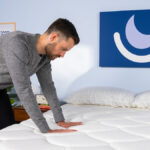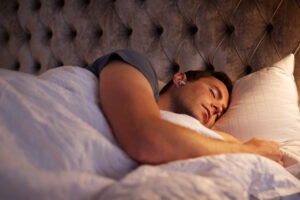Alida Abdullah, 46, an educator and mother of four in Atlanta, spent decades taking for granted that she was tired much of the time. She would fall asleep at inopportune times, even nodding off while driving. Even so, Abdullah didn’t consider that she had a sleep condition. “I thought I was just sleepy and didn’t get enough rest,” she says.
In her early thirties, someone asked if she’d ever had a sleep study, an overnight test used to evaluate sleep disorders. She decided to get one. During the titration part of the study, she used a continuous positive airway pressure (CPAP) machine and was astonished by the result.
“When I woke up, I kid you not, I had never felt so refreshed in my entire adult life,” she says. She was diagnosed with severe obstructive sleep apnea (OSA), a common form of sleep-disordered breathing.
While sleep apnea may be more common in men, it still affects women. In fact, about 1 in 4 women are at high risk for the condition. However, by one estimate, over 90% of women with sleep apnea go undiagnosed.
The reasons for this are complicated. Contributing factors include a lack of understanding of the gender and sex differences in sleep medicine, gaps in sleep research, and limited public health efforts to raise awareness that sleep apnea is not just a “man’s disease”.
As a result, primary care doctors may not always ask women about sleep issues or sleep apnea symptoms. Further complicating matters is that women may not develop sleep apnea until certain stages in life due to hormonal changes.
Common misconceptions about sleep apnea often mislead women into thinking they couldn’t have the condition. The stereotype is that sleep apnea only affects older men, but young women can also be diagnosed with the disorder.
Snoring is known to be one of the hallmarks of sleep apnea. But women are less likely to snore than men and more likely to have other symptoms, like tiredness, often attributed to other health issues. And while obesity is a risk factor for sleep apnea, women who are not overweight can still be affected.
Snoring? An At-Home Sleep Test May Be the Answer
Save 54% on your Sleep Test Today
Simple and convenient
- Equipment delivered to your doorstep
- One overnight test in the comfort of your own bed
Uncover sleep apnea
- Quietly collects data while you sleep
- 98% effective in detecting sleep apnea
Affordable & ships fast
- In-lab sleep tests cost ~$3,000+ (this one’s $189), HSA/FSA eligible
- Arrives in 2-4 business days
The Knowledge Gap
One reason why sleep apnea can go diagnosed in women is that doctors often respond differently to their female patients, says Dr. Valerie Cacho, an integrative sleep physician and founder of Sleephoria, an online resource for women’s sleep health. When women tell their doctors they’re tired, they’re often told to get their thyroid checked, or they’re sent to a therapist, she says. Both thyroid problems and depression can also cause tiredness. But “a man who’s tired and goes to his doctor will probably get a sleep study,” Dr. Cacho says.
This was the case for 46-year-old Florida resident Emma Cooksey, a patient advocate, writer, and podcast host. When she was 30, she consulted her doctor about sleep problems. “I said, ‘I’m really exhausted no matter how much I sleep,’” she recalls. “I was told, ‘You’re anxious and depressed. Let’s treat you for that.’”
Cooksey left the doctor’s office with the impression that sleep disorders are rare and sleep apnea only affects older men. She was told she didn’t have enough risk factors for sleep apnea to warrant testing.
The doctors also attributed Cooksey’s tiredness to her having a baby, even though her child was already sleeping through the night. When she fell asleep driving and narrowly avoided a collision, she knew she had to step up her self-advocacy. She said to herself, “I really need to be referred to somebody that knows about sleep.”
Part of the knowledge gap among physicians comes from sleep apnea presenting differently in women, with less overall snoring and more fatigue, says Dr. Joseph Krainin, a neurologist and sleep medicine physician. Women also tend to have more of an issue with staying asleep than falling asleep.
“You’ll hear women complain that they wake up at 3:30 a.m. every night, and sleep doctors like me realize that that is the main manifestation of their sleep apnea,” Dr. Krainin says. However, not all physicians recognize these as signs of sleep apnea.
Identifying Sleep Apnea in Women
Some women may not know they can go most of their lives without a sleep disorder and then develop one at an older age.
“In the years before menopause, there’s something protective about the sex hormones,” Dr. Krainin says. Though not yet fully understood, it’s thought that the hormones estrogen and progesterone help keep muscles of the upper airway toned and less likely to collapse during sleep. As sex hormone levels drop after menopause, women’s risk of sleep apnea increases. “When women go through menopause, their rates of obstructive sleep apnea catch up with those of men,” Dr. Krainin says.
Women may also have their own preconceived ideas about sleep apnea. Abdullah admits that she used to think only older, overweight men had sleep apnea. She says the image of Homer Simpson comes to mind.
“I didn’t know it could look like me,” she says. “Somebody who is active, who had been an athlete, and doesn’t smoke or drink.”
There are differences between how men and women talk about their symptoms, too. Some women may be reluctant to report that they snore, due to a perception that snoring could be seen as “unladylike.” Many women also put pressure on themselves to “muscle through” exhaustion, chalking it up to busy schedules, work, and parenting.
Beyond tiredness, some signs of a sleep disorder might include headaches in the morning, mood disturbances, and early morning awakenings, says Dr. Cacho. She urges people to seek a sleep study and educate themselves about the condition if they notice any of these symptoms.
Finding Care and Community
When Cooksey was finally diagnosed with sleep apnea and started using a CPAP machine, many of her worst symptoms improved. Still, it took her months to adapt. It’s common for people to experience side effects from CPAP machines, and some decide to abandon the treatment altogether.
Abdullah found CPAP therapy uncomfortable and challenging to keep up with, especially since she was breastfeeding and co-sleeping with her child at the time. She eventually got an oral appliance from a doctor. It helped but didn’t fully solve the problem. She now wants to be evaluated for a deviated septum — which can raise the risk of sleep apnea but can also be corrected with nasal surgery.
Dr. Cacho believes an aversion to CPAP machines keeps some people from undergoing testing because they think that’s the only solution.
“While CPAP is the best treatment option we have at this point, it’s not the only one,” says Dr. Cacho. “There are other options, like side sleeping, surgeries, mouth guards, weight loss, dental appliances, and more. Don’t let the thought of being on a CPAP machine keep you from taking care of yourself.”
For Abdullah, finding solutions to her sleep issues has been time-consuming and expensive. She’s taken solace in finding support in a community with other people diagnosed with sleep disorders, like Cooksey. The two are active with Project Sleep, a nonprofit organization raising awareness about sleep health. Cooksey also helps raise awareness through her podcast Sleep Apnea Stories.
Researchers continue to study the differences in men’s and women’s sleep health to bridge knowledge gaps. Still, women with sleep apnea can benefit from efforts to improve OSA care.
The American Academy of Sleep Medicine suggests increasing sleep medicine training and education for medical students and physicians, expanding the roles of nurse practitioners and physician assistants in OSA screening and diagnosing, and adopting new technologies to improve OSA screening. Implementing public health campaigns such as the Obstructive Sleep Apnea Awareness Project can raise awareness and encourage women to talk to their doctor.
Meanwhile, any effort to get treated for sleep apnea is likely to improve your sleep, quality of life, and overall health, Dr. Krainin says. You may experience fewer awakenings during the night and wake up feeling more refreshed and energetic.
“It’s all going to get better with treatment of your sleep apnea,” Dr. Krainin says.
Think you may have sleep apnea? Skip the lab – get a home sleep test today.
References
Ask the Sleep Doctor
Have questions about sleep? Submit them here! We use your questions to help us decide topics for articles, videos, and newsletters. We try to answer as many questions as possible. You can also send us an email. Please note, we cannot provide specific medical advice, and always recommend you contact your doctor for any medical matters.


